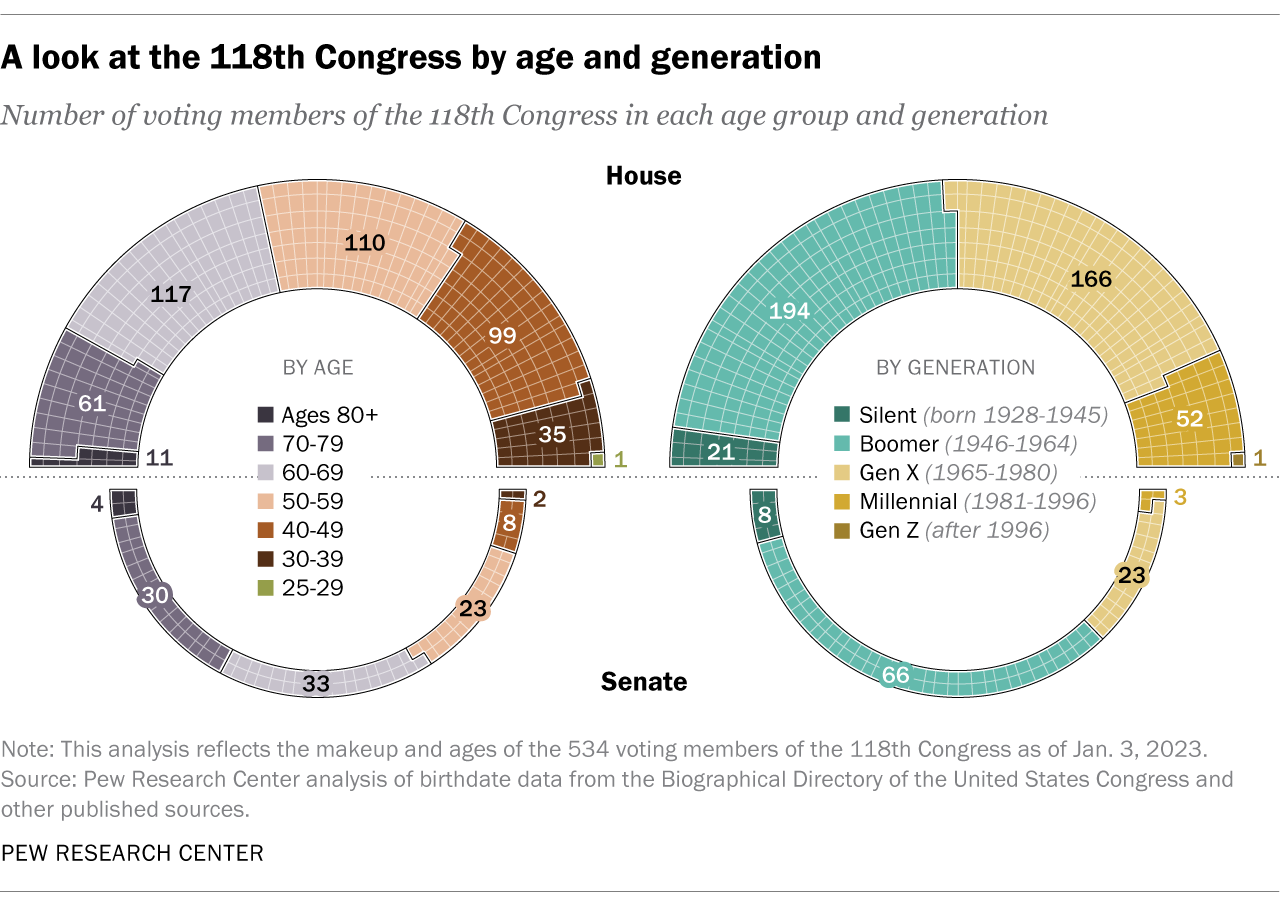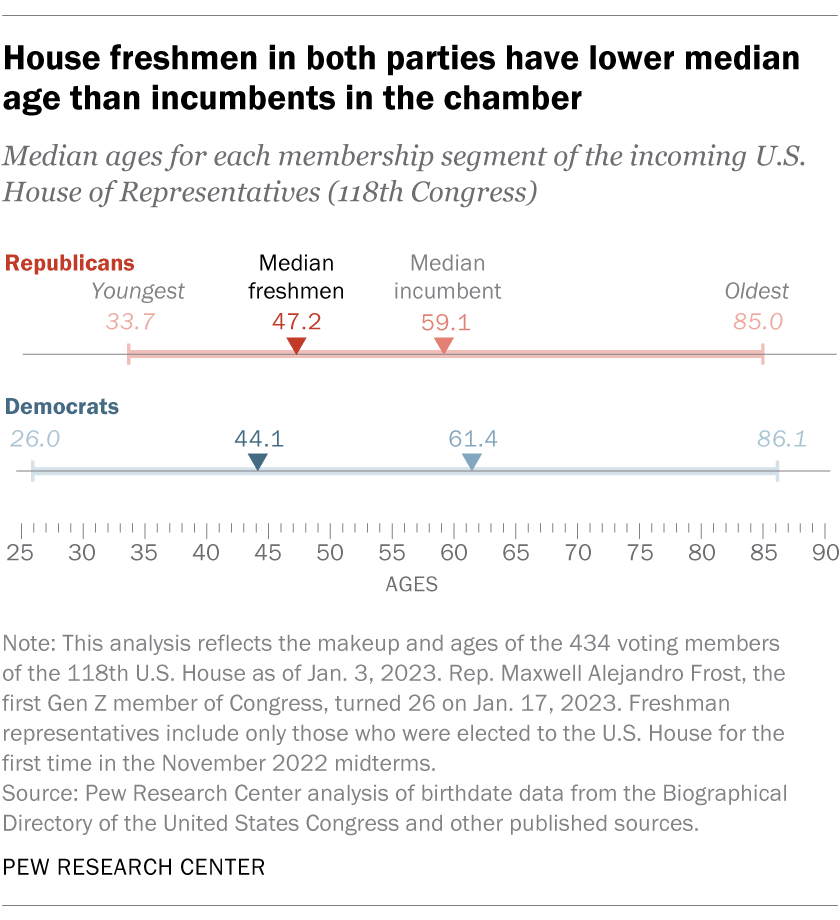
The U.S. House of Representatives is getting younger – at least a bit – while the Senate’s median age continues to rise, according to a Pew Research Center analysis of the newly installed 118th Congress.
The median age of voting House lawmakers is 57.9 years, down from 58.9 in the 117th Congress (2021-22), 58.0 in the 116th (2019-20) and 58.4 in the 115th (2017-18). The new Senate’s median age, on the other hand, is 65.3 years, up from 64.8 in the 117th Congress, 63.6 in the 116th and 62.4 in the 115th.
This Pew Research Center analysis examines the age and generational composition of the 118th Congress, including how it differs from that of prior Congresses.
For this analysis, we obtained ages and birthdates of members of the 118th Congress from the online Biographical Directory of the United States Congress and other published sources such as The Hill’s new members guide and CQ Roll Call. Historical data for the 115th, 116th and 117th Congresses came from prior Pew Research Center analyses.
For the 118th Congress, this analysis reflects the ages of 534 voting members as of Jan. 3, 2023, with one exception: Sen. Pete Ricketts, R-Neb., is included despite not being seated until Jan. 23, 2023. Virginia’s 4th District seat, vacant after Democrat Donald McEachin’s recent death, is excluded from the analysis. Freshmen lawmakers include only those who were elected for the first time in the November 2022 midterms.
For the 117th Congress, the analysis reflects the 532 voting members seated as of Feb. 8, 2021, and ages were as of that date. For the 116th Congress, the generational makeup of the House was calculated as shares of the 432 seats called as of Nov. 21, 2018; ages were effective Jan. 3, 2019. Senate figures were based on all 100 members seated as of Jan. 3, 2019. For the 115th Congress, the analysis reflects the makeup and ages of all 535 voting members as of Jan. 3, 2017.
Independent members of Congress are counted with the party they caucus with.

The House’s median age has ticked down because newly elected, first-time members are predominantly in their 40s or younger. Of the 73 freshman representatives in the House – those who were elected for the first time in the November 2022 midterms – 31 are in their 40s, 15 are in their 30s and one – Rep. Maxwell Alejandro Frost, D-Fla. – just turned 26 in January. The remaining new lawmakers are in their 50s or 60s.
A large majority of the 118th House’s first-time members (64 of 73) are below the chamber’s median age of 57.9. The median age of new representatives is 46.3, down from 52.1 among new members in the prior Congress.
The Senate, for its part, has gotten older even though the median age of the eight new senators in the 118th Congress is far below that of the chamber as a whole (49.4 vs. 65.3). Three of the new senators, all Republicans, are in their 40s, while another new Republican – J.D. Vance of Ohio – is in his 30s. Three other new senators, including two Republicans and one Democrat, are in their 50s, while another new Democrat, Peter Welch of Vermont, is in his 70s.
Differences by party

In the House, the 39 freshman Republican representatives skew somewhat older than the 34 new Democratic House members. The median age of freshmen House Republicans is 47.2, compared with 44.1 for first-time Democrats in the chamber.
Overall, the median age of House Democrats is 58.1, while the median age of House Republicans is 57.4. In the Senate, Democrats’ median age is nearly on par with that of Republicans (65.4 vs. 65.3).
New Congress has more Millennials and Gen Xers – and fewer Boomers
Another way to look at the age of the new Congress is through the lens of generation.
In Congress overall, older generations – that is, Baby Boomers (born 1946-64) and the Silent Generation (1928-45) – constitute 54% of all members. This is only a slight edge over younger generations – Generation Z (born after 1996), Millennials (1981-96) and Generation X (1965-80) – who together make up 46% of members.

In the House, most of the freshman lawmakers are Generation Xers (39) or Millennials (24), while Frost is the first-ever Generation Z member of Congress. The remaining first-time members are Baby Boomers.
Overall, 52 members of the 118th House are Millennials, up from 31 in the 117th Congress and 26 in the 116th. Members of that generation, who are between the ages of 27 and 42 in 2023, now represent 12% of all current voting House members and are divided equally between Republicans and Democrats.
In addition, 166 House members are Gen Xers, who are between the ages of 43 and 58 in 2023. That number is up from 144 in the 117th Congress and is second in size in the new Congress only to Boomers (194), who are between the ages of 59 and 77 this year. Gen X’s share of the House now stands at 38%, up from 33% in the last Congress. Republicans hold a slight edge in this generation with 88 members, compared with 78 Democrats.
Collectively, younger generations – Gen X, Millennials and Gen Z – have about as many House members (219) as Boomers and the Silent Generation combined (215). Boomers’ share of the House continues to decline – to 45%, down from 53% in the 117th Congress – though it is still larger than any other generation represented in the chamber. The ranks of the Silent Generation, who are between the ages of 78 and 95 in 2023, continue to dwindle: Just 21 Silent Generation members remain in the House, or 5% of the whole chamber – down from 27, or 6%, in the previous Congress.
In the Senate, Boomers continue to dominate, with 66 senators in this generation. That is slightly down from the previous Congress (68) but in line with the two before it (66 and 65, respectively). The number of Silent Generation senators has fallen to eight. As recently as the 115th Congress (2017-18), 19 senators were part of that generation. The number of Gen X senators has ticked up to 23, compared with 20 in the previous Congress.
The changing generational profile of Congress is linked to other shifts that are taking place on Capitol Hill. For example, the slow decline in lawmakers who are members of the Baby Boom or Silent generations – many of whom came of age during the U.S. military engagements in Korea and Vietnam – has accompanied a long-term decrease in the share of legislators who are veterans. And the arrival of younger generations of lawmakers has brought additional changes, including growing racial and ethnic diversity in Congress.




